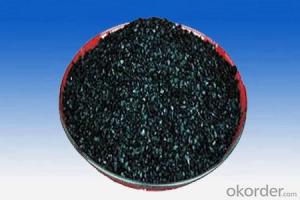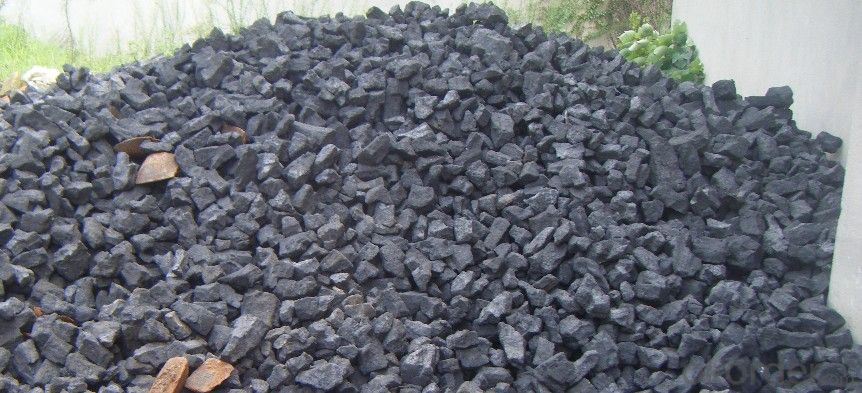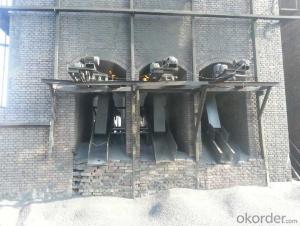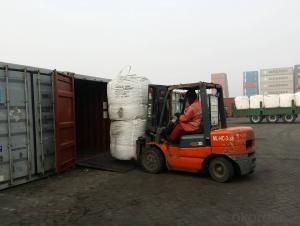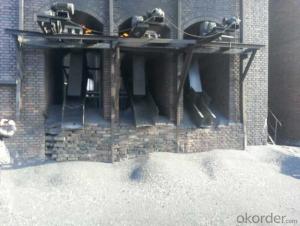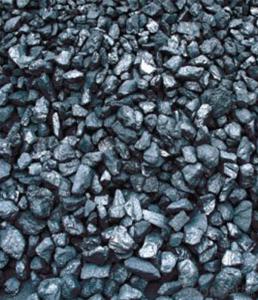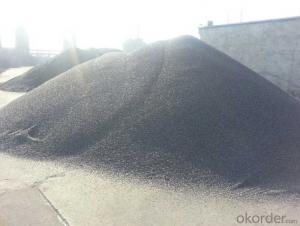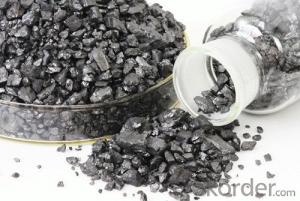FC92 Calcined Anthracite With Good Delivery Time And Service
- Loading Port:
- Tianjin
- Payment Terms:
- TT OR LC
- Min Order Qty:
- 0 m.t.
- Supply Capability:
- 100000 m.t./month
OKorder Service Pledge
OKorder Financial Service
You Might Also Like
Packaging & Delivery
| Packaging Detail: | 25kgs/50kgs/1ton per bag or as buyer's request |
| Delivery Detail: | Within 20 days after receiving corect L/C |
Specifications
Calcined Anthracite
Fixed carbon: 90%-95%
S: 0.5% max
Size: 0-3. 3-5.3-15 or as request
Our Products:
•Feature: All of our goods are made in the best quality of world famous Tianjin. All of our products are with High carbon, Low ash, low sulphur, Low Moisture.
•Application:
The Calcined Anthracite Coal/Gas Calcined Anthracite Coal/Carbon Raiser is mainly used in steelmaking in electrical stove, screening water, shipbuilding sandblast to remove rust. It can reduce the cost of steelmaking effectively by replacing the traditional petroleum coke of carburant.Also can improve the Carbon content in steel-melting and Ductile iron foundry.
General Specification of Calcined Anthracite:
PARAMETER UNIT GUARANTEE VALUE | |||||
F.C.% | 95MIN | 94MIN | 93MIN | 92MIN | 90MIN |
ASH % | 4MAX | 5MAX | 6MAX | 7MAX | 8MAX |
V.M.% | 1 MAX | 1MAX | 1.5MAX | 1.5MAX | 1.5MAX |
SULFUR % | 0.5MAX | 0.5MAX | 0.5MAX | 0.5MAX | 0.5MAX |
MOISTURE % | 0.5MAX | 0.5MAX | 0.5MAX | 0.5MAX | 0.5MAX |
Size can be adjusted based on buyer's request.
Pictures of Calcined Anthracite:

- Q: What is the carbon content of different types of soil?
- The carbon content of different types of soil can vary significantly depending on various factors such as climate, vegetation, and land management practices. Generally, soils with higher organic matter content tend to have higher carbon content. Peat soils, for example, have the highest carbon content among all soil types, ranging from 30% to 60%. These soils are formed in wetland areas where the decomposition of organic matter is slow due to water saturation. As a result, large amounts of carbon accumulate over time. Forest soils also tend to have relatively high carbon content, varying between 1% and 10%. Forests provide a continuous supply of organic matter through litterfall, which contributes to the build-up of carbon in the soil. Agricultural soils, on the other hand, typically have lower carbon content compared to peat or forest soils. The carbon content of agricultural soils is influenced by factors such as crop rotation, organic amendments, and tillage practices. Depending on these factors, carbon content in agricultural soils can range from less than 1% to around 6%. Grassland soils may have carbon contents similar to agricultural soils, depending on the management practices. However, in undisturbed grasslands with high plant productivity, carbon content can be relatively higher, ranging from 2% to 8%. In arid and desert regions, soils tend to have lower carbon content due to limited vegetation and slower organic matter decomposition rates. Carbon content in these soils is often less than 1%. It is important to note that these ranges are generalizations, and the carbon content of soil can vary within and between soil types. Additionally, changes in land use, such as deforestation or conversion of grasslands to agriculture, can significantly impact the carbon content of soils.
- Q: Can barbecue carbon still have the effect of absorbing formaldehyde?
- Yes, there is also a role in the adsorption of formaldehyde in a variety of ways, the following provides 3 commonly used way:1) plants, yelan, Monstera can remove harmful substances in the air, tiger and Chlorophytum Chlorophytum can absorb more than 20% of indoor formaldehyde and other harmful gases; aloe is to absorb formaldehyde players, Milan, etc. wintersweet can effectively remove sulfur dioxide in the air, carbon monoxide and other harmful substances; orchid, osmanthus, Lamei etc. plant cilia to retain and adsorption particles floating in the air and soot.Ivy, cycads can effectively absorb indoor benzene, Chlorophytum can "devour" indoor formaldehyde and hydrogen peroxide, Arisaema also can absorb 40% of benzene, 50% tce. The volatile oils in flowers, such as roses, Osmanthus fragrans, violet, jasmine and carnation also have significant bactericidal effects.
- Q: The printed document will be marked on the document name: carbon copy, no combination number, two links...... What's the meaning of this? What is the connection between the infinite and the two? I MMM
- [2] (Printing Graphic, Arts printing, also use Graphic Communications graphics communication) is the text, pictures, photos, etc. the application of anti-counterfeiting ink, pressure plate, etc., so that the ink transferred to the surface of paper, textiles, plastic products, leather and other materials, bulk copy the content of technology.
- Q: What are carbon offsets?
- Carbon offsets are a mechanism used to help reduce greenhouse gas emissions and combat climate change. They are essentially a way for individuals, organizations, or businesses to compensate for their own carbon dioxide (CO2) emissions by investing in projects that reduce emissions elsewhere. The concept behind carbon offsets is based on the understanding that emissions reduction can be achieved in various ways and at different costs. Instead of solely focusing on reducing their own emissions, carbon offsetting enables individuals or entities to support projects that can achieve greater emission reductions per unit of cost. These projects can include renewable energy, energy efficiency, reforestation, and methane capture, among others. To acquire carbon offsets, individuals or organizations typically calculate their own carbon footprint by assessing the amount of CO2 they emit through their activities, such as energy consumption or transportation. After quantifying their emissions, they can purchase carbon offsets equivalent to the amount of CO2 they have emitted. These offsets are generated by projects that are independently verified and certified by recognized standards and registries. Once the carbon offsets are purchased, they are effectively canceled or retired, ensuring that the emissions reduction achieved by the project is not double-counted or claimed by someone else. By investing in carbon offsets, individuals or organizations can effectively neutralize their own emissions and contribute to global efforts to address climate change. However, it is important to note that carbon offsets should not be seen as a substitute for reducing emissions at the source. They should be used as a complementary tool to support emission reduction efforts, while simultaneously implementing measures to minimize our own emissions through energy efficiency, renewable energy adoption, and sustainable practices.
- Q: What is carbon fiber reinforced plastic?
- By combining carbon fibers with a polymer matrix, namely epoxy resin, carbon fiber reinforced plastic (CFRP) is produced. Its exceptional strength-to-weight ratio sets it apart as a lightweight alternative to conventional materials like steel and aluminum. The carbon fibers offer high tensile strength and stiffness, while the polymer matrix evenly distributes the load and ensures durability. The manufacturing process involves layering carbon fiber sheets or fabrics and saturating them with the polymer resin. Subsequently, this combination is cured under high temperature and pressure, resulting in a solid and rigid structure. The resulting material is incredibly strong, yet significantly lighter than materials of comparable strength, such as steel. Thanks to its unique properties, CFRP finds widespread applications in various industries. In aerospace and automotive sectors, it is commonly employed to reduce component weight and enhance fuel efficiency. Moreover, it finds use in sports equipment like bicycles, tennis rackets, and golf clubs, as it enables superior performance and maneuverability. The construction industry also utilizes CFRP, benefiting from its high strength and corrosion resistance for reinforcing structures like bridges and buildings. All in all, carbon fiber reinforced plastic is a versatile and high-performance material that combines the strength of carbon fibers with the flexibility of a polymer matrix. Its lightweight nature and exceptional mechanical properties make it a favored choice in industries where strength, weight reduction, and durability are paramount.
- Q: What are the advantages of carbon nanotube transistors?
- Traditional silicon-based transistors are outshined by carbon nanotube transistors for several reasons. Firstly, carbon nanotubes boast exceptional electrical properties with their high electron mobility, enabling swift and effortless electron movement. This results in faster switching speeds and higher operating frequencies, making them a perfect fit for high-performance applications like computers and communication devices. Secondly, carbon nanotubes possess an incredibly small size, measuring a mere few nanometers in diameter. This miniature scale allows for the creation of highly compact and densely packed electronic circuits, leading to elevated integration levels and enhanced device functionality. In comparison, silicon transistors pale in comparison as they have feature sizes several orders of magnitude larger. Moreover, carbon nanotubes exhibit superior heat resistance and thermal conductivity compared to silicon. This exceptional trait enables them to withstand higher temperatures without degradation, resulting in more efficient operation and a reduced need for elaborate cooling systems. Additionally, their ability to endure harsh environments makes them highly suitable for aerospace, automotive, and defense applications. Furthermore, carbon nanotubes are remarkably robust and flexible. They can be bent and stretched without breaking, making them ideal for use in flexible electronics and wearable devices. Their mechanical strength ensures long-term stability and reliability, ultimately leading to improved device performance and longevity. Lastly, carbon nanotube transistors can be fabricated using existing manufacturing processes, making them compatible with current semiconductor technologies. This compatibility allows for their seamless integration into existing electronic systems without the need for significant modifications, thereby reducing both cost and implementation time. All in all, the myriad advantages of carbon nanotube transistors, including their exceptional electrical performance, small size, thermal stability, mechanical strength, and compatibility with existing manufacturing processes, position them as a promising alternative to traditional silicon transistors for future electronic applications.
- Q: How does carbon impact the formation of smog?
- The formation of smog is greatly influenced by carbon, specifically carbon monoxide (CO) and volatile organic compounds (VOCs). When fossil fuels are burned, like in vehicle engines or power plants, they release carbon monoxide into the air. This colorless and odorless gas can react with other pollutants under sunlight to create ground-level ozone, a major part of smog. Moreover, volatile organic compounds (VOCs), which are carbon-based compounds, are also emitted from various sources such as industrial processes, gasoline vapors, and chemical solvents. These VOCs can undergo chemical reactions with nitrogen oxides and sunlight, resulting in the formation of ground-level ozone. Both carbon monoxide and VOCs contribute to the creation of smog by reacting with nitrogen oxides (NOx) when exposed to sunlight. This reaction produces ground-level ozone, which is a primary component of smog. Ozone is detrimental to human health and the environment, and the presence of carbon emissions worsens its formation. To mitigate the formation of smog, it is crucial to reduce carbon emissions. Transitioning to cleaner and more sustainable energy sources, such as renewable energy, can help decrease the release of carbon into the atmosphere. Additionally, implementing stricter emissions standards for vehicles and industrial processes can also play a role in reducing carbon emissions and consequently limiting the formation of smog.
- Q: What are the effects of carbon emissions on human respiratory health?
- Human respiratory health can be significantly affected by carbon emissions. Carbon dioxide (CO2) is a primary component of carbon emissions and contributes to both air pollution and climate change. The presence of high levels of carbon dioxide in the atmosphere can result in the concentration of other pollutants like nitrogen oxides, sulfur dioxide, and particulate matter increasing. Exposure to these pollutants, particularly fine particulate matter (PM2.5), has been associated with various respiratory issues. Inhaling PM2.5 can cause irritation in the airways, leading to symptoms such as coughing, wheezing, and breathlessness. It can also worsen existing respiratory conditions like asthma, chronic obstructive pulmonary disease (COPD), and bronchitis. Long-term exposure to elevated levels of PM2.5 has been linked to the development of respiratory diseases and can contribute to higher hospital admissions and mortality rates. Moreover, carbon emissions contribute to the creation of ground-level ozone, a harmful pollutant that plays a significant role in smog formation. Ozone can cause inflammation and damage to the respiratory system, resulting in respiratory symptoms and reduced lung function. It can also aggravate pre-existing respiratory conditions and increase the susceptibility to respiratory infections. Apart from these direct effects, carbon emissions also contribute to climate change, which indirectly impacts respiratory health. Climate change can lead to more frequent heatwaves and extreme weather events, which can worsen air quality and trigger respiratory symptoms. It can also alter the distribution of allergens like pollen, mold spores, and dust mites, thereby increasing the prevalence of respiratory allergies and asthma. Overall, carbon emissions have substantial adverse effects on human respiratory health. They contribute to air pollution, which can cause respiratory symptoms, worsen existing respiratory conditions, and elevate the risk of developing respiratory diseases. Additionally, they contribute to climate change, which indirectly affects respiratory health by influencing air quality and the prevalence of allergens. Therefore, reducing carbon emissions and improving air quality are vital for safeguarding and promoting respiratory health.
- Q: What is carbon neutral packaging?
- Packaging that is carbon neutral is characterized by having no carbon footprint. This implies that the emissions of carbon dioxide (CO2) released during the production, transportation, and disposal of the packaging are counterbalanced by an equal amount of CO2 being removed from the atmosphere or not emitted in the first place. To achieve carbon neutrality, a range of strategies can be implemented. One commonly used method is to utilize renewable or recycled materials for packaging, such as paper or bioplastics derived from plant-based sources. These materials have a lower carbon footprint compared to traditional petroleum-based plastics. Furthermore, reducing the quantity of packaging used overall and optimizing its design to minimize waste can also contribute to carbon neutrality. Offsetting unavoidable emissions is another crucial aspect of carbon neutral packaging. This can be accomplished by investing in projects that reduce greenhouse gas emissions elsewhere, such as reforestation or renewable energy initiatives. By supporting these projects, the carbon emissions produced by the packaging are counteracted, resulting in no overall impact on the environment. The concept of carbon neutral packaging is gaining traction as businesses and consumers become more cognizant of the environmental consequences of their choices. It offers a means to decrease the carbon footprint associated with packaging, ultimately contributing to a more sustainable and environmentally friendly future.
- Q: How does carbon impact the quality of freshwater systems?
- Carbon can impact the quality of freshwater systems in various ways. Carbon dioxide (CO2) dissolved in water can lower its pH, leading to increased acidity and potentially harming aquatic organisms. Additionally, excessive carbon inputs from human activities like the burning of fossil fuels can contribute to eutrophication, causing algal blooms and depleting oxygen levels in water bodies, further compromising the health of freshwater ecosystems.
Send your message to us
FC92 Calcined Anthracite With Good Delivery Time And Service
- Loading Port:
- Tianjin
- Payment Terms:
- TT OR LC
- Min Order Qty:
- 0 m.t.
- Supply Capability:
- 100000 m.t./month
OKorder Service Pledge
OKorder Financial Service
Similar products
Hot products
Hot Searches
